A project charter is a fundamental document in project management. It is the formal authorization for the existence of a project and the road map for its execution and control. The charter serves as both a directive and a contract. It facilitates the project manager’s authority to allocate organizational resources to project activities.
A Project Charter (PC) explains the direction your organization is taking and why,
what will change, and what risks will arise.
Creating a project charter is a fundamental step that aligns with the best practices outlined by the Project Management Institute (PMI). For professionals who are certified as a Project Management Professional (PMP), the creation of a project charter is an essential skill set. This PMI certification ensures that project managers can apply global project management standards, including the standards for initiating and scheduling projects.
This document not only contains basic information, but also reflects the overall vision of the stakeholders. The project charter is usually created at the earliest stage of the project, before the project team (PT) is formed. It is typically written in collaboration with other project participants and submitted to stakeholders for final review. The charter is signed by the sponsors in most cases.
Defining the Project Charter
What is a Project Charter in Project Management?
The project charter definition encompasses a formal document that not only defines the scope, objectives, and participants of a project but also serves as a foundational tool in the project management process. This essential document outlines the project’s goals, key stakeholders, budget, schedule, and overall direction, providing a critical framework for guiding the project’s execution and management.
The charter authorizes the project manager to use organizational resources to achieve the objectives and is typically approved at the beginning of the project lifecycle. It is better to fit all the information into a maximum of 1 – 2 pages.
For example, the project charter can look like a text document, a Google doc, or a presentation. You can also use a project management system with the possibility of specification of the project charter in the description.
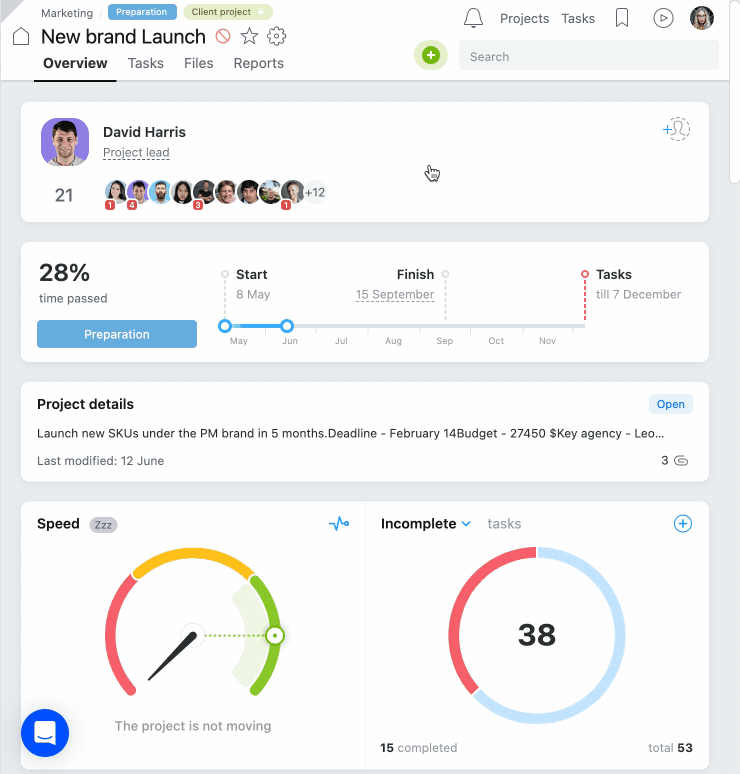
Project description on the Worksection project dashboard
What does the PC clarify?
- What kind of professional becomes a Project Manager (PM) and what are his/her responsibilities?
- The purpose of the project and its relationship to business metrics
- Who approves and funds the project
- The composition of the project team, the requirements and expectations of the project, and the responsibilities of each participant
- Criteria for success
Project Charter vs. Project Plan
The project charter is created in the early stages of a project to broadly define the vision and scope of the project. It includes high-level project details such as objectives, key stakeholders, and the project manager’s level of authority. Conversely, a project plan is developed after the project charter and provides detailed information on how the project will be executed, monitored, and closed. The project plan includes detailed schedules, resource allocations, risk management plans, and communication plans.The project charter sets the strategic framework for a project and provides a macro view of the necessary elements for project initiation. In contrast, the project plan serves as a tactical guide that manages the execution phase of the project, focusing on the operational details and logistics of project management.
The relationship between the project charter and the project plan is synergistic, as the clarity and direction provided by the charter directly influences the detailed planning and ultimate success of the project. The charter provides initial alignment with the organization’s strategic goals, while the plan operationalizes those goals into actionable steps, schedules, and resource plans.
Purpose of a Project Charter
Three critical risks underline the importance of having a well-drafted project charter, which can make or break the success of a project:
- Lack of Authority and Resources: Without a project charter, the project manager may face significant hurdles in exerting authority and securing necessary resources. The charter serves as an official document that gains stakeholder approval, essentially granting the project management the mandate to operate within defined parameters. This approval is crucial as it supports the project manager in acquiring the necessary resources and authority without having to constantly negotiate or justify each decision, thus preventing delays and disruptions.
- Unclear Project Expectations: A project without a charter risks having nebulous goals, leading to scope creep — a situation where the project’s goals expand beyond the original plans without proper control. A charter outlines the project’s objectives and deliverables clearly, setting a defined path and expectations from the outset. This clarity helps in maintaining focus and aligning the project team’s efforts with the predefined outcomes, thereby reducing the likelihood of project sprawl and misaligned deliverables.
- Misalignment with Organizational Goals: Projects initiated without a charter may inadvertently stray from or contradict the broader organizational goals. A well-constructed charter links the project to the organization’s strategic objectives, explaining how the project contributes to the overall business strategy. This alignment is crucial for securing ongoing support from upper management and ensuring that the project contributes positively to the company’s long-term success.
Key Components of a Project Charter
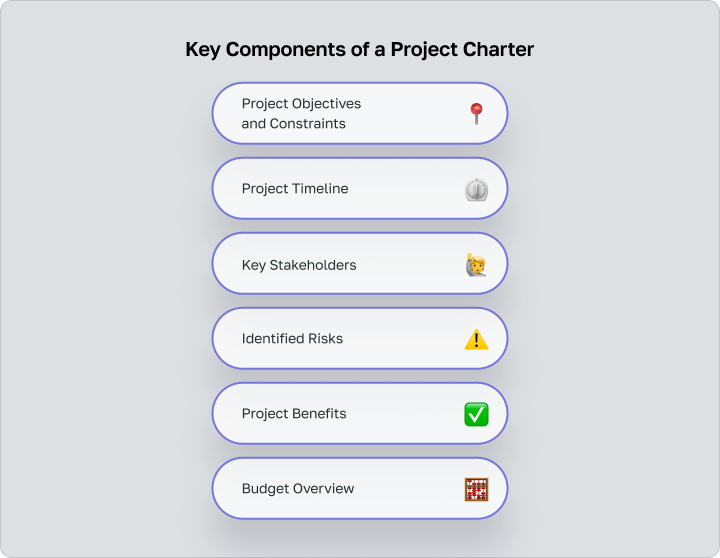
 Project Objectives and Constraints
Project Objectives and Constraints
A project charter outlines the primary objectives of the project, specifying the desired outcomes that align with broader organizational goals. It also details the constraints or limitations within which the project must operate, such as budget limits, time constraints, resource availability, and specific scope boundaries. The articulation of both goals and constraints in the charter is critical. This dual focus guides every phase of the project lifecycle, from planning through execution, ensuring that the project stays on track while efficiently managing resources and stakeholder expectations.
Setting clear objectives provides the project team with a measurable standard against which to measure progress and success, while constraints help ensure that the project does not overreach and remains focused on essential deliverables. Together, these elements frame a strategic approach that is critical to aligning the project with the overall strategic direction of the organization, facilitating effective decision-making and project management practices.
 Project Timeline
Project Timeline
The project timeline is an essential component of the project charter. It details the start and end dates of the project and maps out key milestones and deadlines. The inclusion of a timeline in the project charter helps in setting a clear schedule that all project participants can follow. It serves as a tool for monitoring progress and ensures that the project remains on track to meet its defined objectives within the allocated time. Effective timelines are not just schedules; they are strategic tools that help manage resources, adjust priorities, and mitigate potential delays or risks.
 Key Stakeholders
Key Stakeholders
Identifying key stakeholders in the project charter is crucial for project success. Stakeholders typically include anyone impacted by the project or those who have influence over the project outcome. This group might include project sponsors, team members, customers, end-users, or external suppliers. The charter should explicitly define the roles, responsibilities, and expectations of each stakeholder to foster transparency and accountability.
Understanding who the stakeholders are and their respective stakes in the project is essential for developing tailored communication and project management strategies that support collaborative and effective project execution. Precisely identifying these stakeholders ensures that all necessary inputs are considered and that the project addresses all relevant interests and requirements, which is critical for achieving the desired outcomes and ensuring project alignment with broader business objectives.
 Identified Risks
Identified Risks
The project charter must anticipate and outline potential risks that could impact the project’s trajectory from its outset. These risks might include budgetary constraints, timeline delays, technological failures, resource availability, or external factors such as regulatory changes. Documenting these risks is crucial as it prepares the project team to handle challenges proactively. Effective risk identification helps in developing mitigation strategies that can be implemented should these risks materialize, ensuring that the project remains on track towards its objectives.
 Project Benefits
Project Benefits
The project charter should clearly articulate the benefits expected from completing the project. These benefits often align with strategic business goals and can include increased efficiency, cost savings, enhanced customer satisfaction, or competitive advantages. Highlighting these benefits is essential not only for justifying the project’s initiation but also for maintaining stakeholder engagement and support throughout the project lifecycle. It provides a clear vision of what the organization aims to achieve, serving as a continual reference point for the project’s value proposition.
 Budget Overview
Budget Overview
The budget summary in a project charter is critical to establishing the financial framework for a project. This section not only provides a detailed estimate of the funds needed to cover all expected costs-such as labor, materials, technology, and contingencies-but also anticipates potential financial overruns and includes plans for such instances.
In defining these financial parameters, the project charter helps stakeholders understand the economic feasibility and resources required, facilitating better investment decisions and financial oversight. This comprehensive financial outline ensures that all project participants are aware of the cost implications and financial responsibilities, which is critical to maintaining transparency and preventing budget overruns, thereby ensuring the financial viability of the project.
Crafting a Project Charter
Step-by-Step Guide to Creating a Project Charter
Step 1 Understand key project goals and objectives
Start by clearly defining what the project aims to achieve. Engage with key stakeholders to gather insights and expectations. List 3 – 5 smaller goals to be accomplished as the project progresses. Make sure they are specific, measurable, achievable, relevant, and time-bound. In other words, they are SMART.
Analyze how the project may affect the organization’s business performance.
Step 2 Define project organization
Outline the structure of the project team and identify roles and responsibilities. This includes specifying who the project manager is, defining the roles of team members, and establishing the hierarchy and communication channels within the team. Clarifying this early helps prevent confusion and sets the framework for accountability and authority within the project.
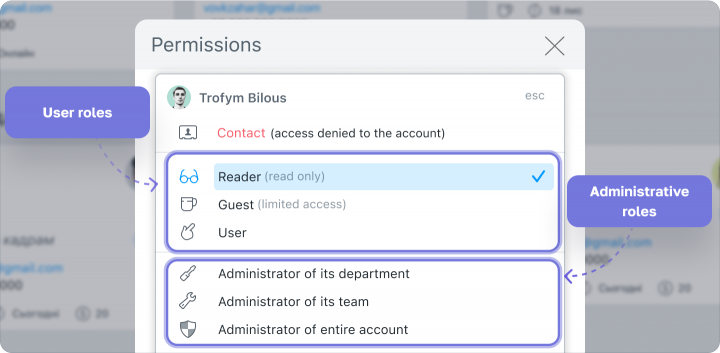
Worksection provides you with a clear structure of who is involved in a project, allowing you to easily organize working within a team as well as with clients and freelancers.
Step 3 Create an implementation plan
Develop a detailed plan that outlines how the project objectives will be achieved. This should include the phases of the project, key activities, milestones, and deadlines. The implementation plan should also detail the resources required for each stage of the project, including time, budget, and human resources.
Step 4 List potential problem areas
Perform a risk assessment to identify potential problems such as resource allocation, delayed schedules, or external dependencies. Outline mitigation strategies for these risks. This proactive approach not only prepares the team to handle difficulties. It also demonstrates thorough planning and foresight.
Post-Creation Steps
The next steps in moving a project from planning to execution are critical after the project charter is created. These steps after the creation of the project charter ensure that the project is formally approved and that the scope of the project is clearly defined and agreed upon by all stakeholders.
Step 1 Authorize the project
The first step after the creation of the project charter is to obtain formal approval for the project. This is typically the review and approval of the project charter by key stakeholders such as project sponsors, senior management, or the project board.
Approval serves as an official green light that the project is aligned with strategic goals and has the necessary backing in terms of resources and executive support. It also authorizes the project management to allocate resources and make necessary project-related decisions.
Step 2 Develop a scope statement
The development of a detailed scope statement is critical once the project is approved. This document provides a more detailed description of the project’s deliverables, boundaries, and acceptance criteria, building on the initial scope outlined in the project charter.
To prevent scope creep, the scope statement should clearly state what is included and what is excluded from the project. It also provides a clear reference that stakeholders can agree on and helps define the criteria for what constitutes project success.
Enhancing Your Project Charter
Tips for Effective Project Charters
Creating an efficient and concise project charter is crucial for setting the stage for a successful project. Here are some practical tips to enhance the quality and effectiveness of your project charters:
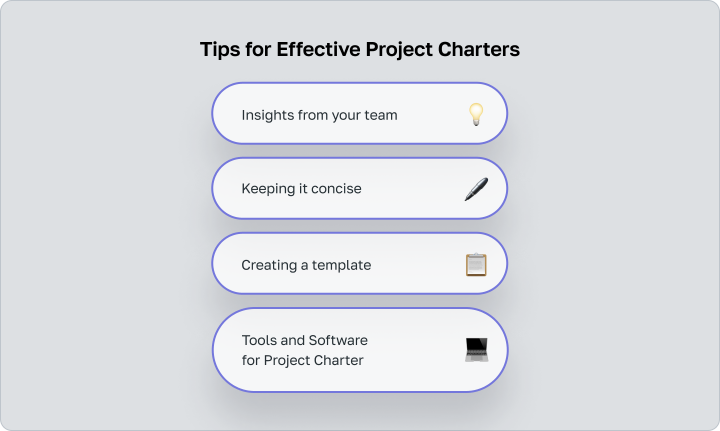
 Insights from your team
Insights from your team
Include feedback and insights from team members who will be directly involved in the project. Early engagement with your team can provide valuable perspectives that improve the relevance and feasibility of the charter. It ensures that the charter reflects a comprehensive understanding of the project’s requirements and challenges from those who will be executing it.
 Keeping it concise
Keeping it concise
A concise project charter is more effective and easier to use. Focus on including only essential information such as project objectives, key stakeholders, key risks, and scope. There should be no overloading of the document with too much detail, which can be reserved for the project plan. Use clear and direct language to help stakeholders quickly understand what the project aims to accomplish and how to participate.
 Creating a template
Creating a template
Develop a standardized template for your project charters to streamline the creation process for future projects. A template ensures consistency in how information is presented and makes it easier for stakeholders to find relevant details. Include sections that cover all critical aspects of a project charter, and customize the template as necessary based on lessons learned from past projects.
 Tools and Software for Project Charter
Tools and Software for Project Charter
Using the right tools and software is critical to improving the creation and management of project charters. Worksection is an example of a project management software with features tailored to the development and maintenance of project charters.
This platform facilitates collaborative project creation, simplifies updates, and integrates with other project management tools. It streamlines processes by allowing team members to work together on documents in a seamless manner, ensuring consistency and accuracy throughout the entire documentation of the project. In addition, Worksection promotes transparency and effective communication by centralizing all project-related documents in a single, accessible location, so that each team member has instant access to all project documents.
This is critical for maintaining alignment and facilitating timely decision-making within project teams, ensuring that each team member has instant access to the latest updates and information.
Project Charter Templates and Examples in Worksection
You can add a project charter in Worksection using the Project Description feature. For that purpose, go into the project settings:
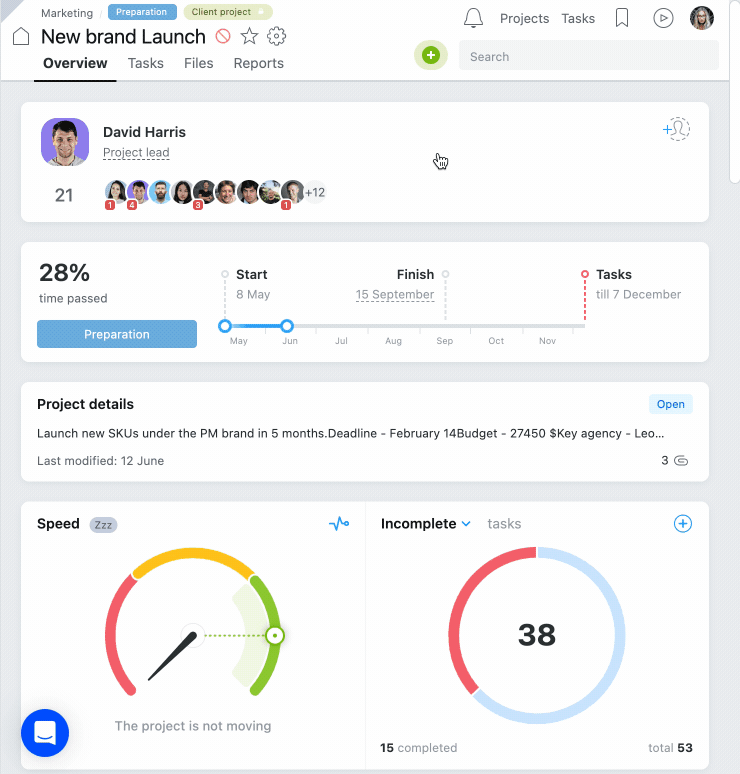
The next step is to fill in the required information and save the data. You can also attach a Project Charter file directly to the Description to make sure the team can access the information needed.
Project charter template
Here’s a basic template with information what does project charter include. You can customize according to your project’s specific needs:
- Project Title: Provide a concise title that reflects the nature of the project.
- Project Sponsor: Name and department of the person who is sponsoring the project.
- Project Manager: Name and contact information of the individual responsible for managing the project.
- Objectives: Clearly defined goals that the project aims to achieve.
- Scope: Outline what is included and excluded in the project. Specify the boundaries to clarify where the project begins and ends.
- Key Stakeholders: List the main individuals or groups interested in the outcome of the project and their roles.
- Milestones: Major milestones and their expected completion dates.
- Resources: Summary of the budget and other resources allocated to the project.
- Benefits: Describe the anticipated benefits of completing the project.
- Sign-off: Signatures of the project sponsor, project management, and key stakeholders.
- Appendices: Any additional information necessary for understanding the project, such as detailed budget breakdowns or technical specifications.
Example of a project charter in Worksection
This is how you can create project charter using the template in Worksection:
FAQs about Project Charters
 Who should draft the project charter?
Who should draft the project charter?
The project charter is ideally written by the project leader with input from the project participants, incorporating all vital project charter elements. This collaborative approach ensures that the charter covers both the strategic vision of the organization and the practical aspects of project execution comprehensively. Senior project management or the project sponsor’s involvement is crucial in giving the charter the necessary authority and ensuring it aligns with broader business objectives, making these elements essential to the success and organizational alignment of the project.
 Can the project charter be edited throughout the project lifecycle?
Can the project charter be edited throughout the project lifecycle?
Yes, the project charter may be subject to updates during the project life cycle, although such changes should generally be minimal. Significant changes in scope, resources, or objectives may require revisions. To maintain clarity and consensus on the project’s direction, any changes should be made with the agreement of key stakeholders and formally documented.
 Best practices for presenting the project charter to the team
Best practices for presenting the project charter to the team
Presenting the Project Charter effectively means clearly communicating its key components to ensure that all team members understand the scope of the project, what it’s trying to accomplish, and their individual roles within the project. Best practices include:
- Hold a kickoff meeting: Give team members the opportunity to ask questions and clarify their understanding by reviewing the charter in detail at this meeting.
- Use visual aids: More complex aspects of the charter, such as timelines and dependencies, can be illustrated with charts, graphs, and slides.
- Distribute copies: Make sure that every member of the team has access to the charter, preferably in a format that they can refer to throughout the project.
- Highlight key points: Highlight critical elements such as milestones, key deliverables, and the escalation path for issues.
- Encourage feedback: Allow team members to provide input on the charter, which can help identify potential problems early and engage the team in the project’s success.
Conclusion
A Project Charter is a document that lists the key objectives of the project, defines who’s involved, and establishes criteria for success. By establishing authority and certifying the availability of necessary resources, the charter is important to the project manager and team.
New opportunities and potential risks, methodology, budget, and schedule are disclosed in this document. The charter must demonstrate the project’s benefits to the organization.
Without an up-to-date charter, the project manager and team members risk an ongoing battle for influence and funding. Not having one can also cause the project to get bogged down.